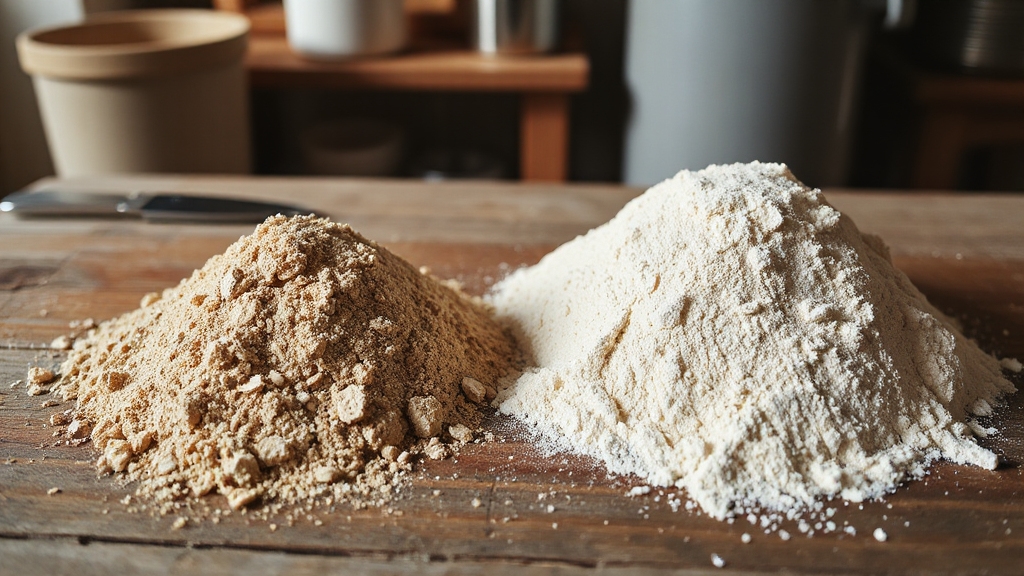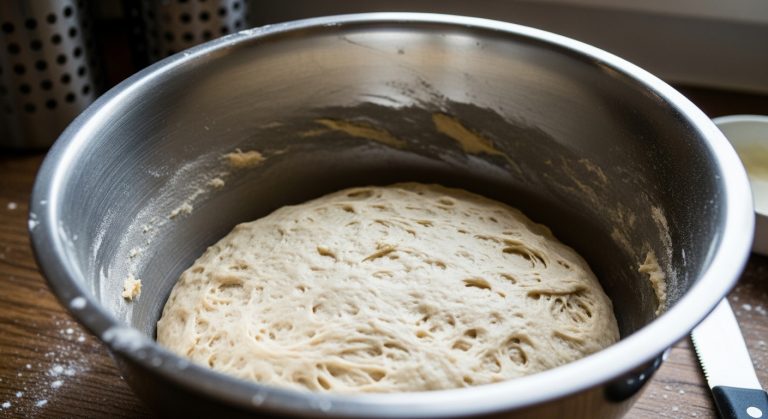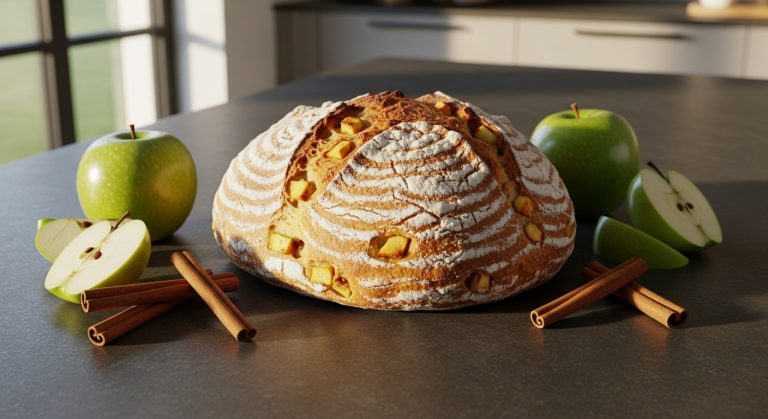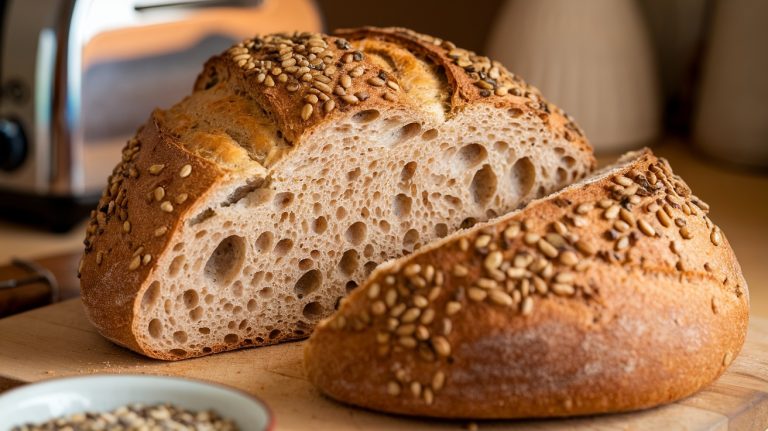Wholemeal Flour vs Whole Wheat Flour: Taste the Difference
If you’re wondering about wholemeal flour vs. whole wheat flour, they’re fundamentally the same thing. Both are made from the entire wheat grain, packing around 12.8 grams of fiber per cup compared to just 3.3 grams in white flour.
You’ll get more nutrients like B vitamins and iron with either. The main difference lies in regional terms—wholemeal in the UK, whole wheat in the US. Curious about baking tips or health benefits? Stick around to explore further.
Key Takeaways
- Wholemeal flour (UK) and whole wheat flour (US) are essentially the same, made from the entire wheat grain.
- Both retain bran, endosperm, and germ, offering higher fiber and nutrients than refined flours.
- Regional wheat types differ: UK often uses white wheat; US uses hard red wheat.
- Texture and color vary slightly due to milling; wholemeal is often coarser and darker.
- Baking requires adjustments for density and hydration with either flour type.
Defining Wholemeal and Whole Wheat Flours
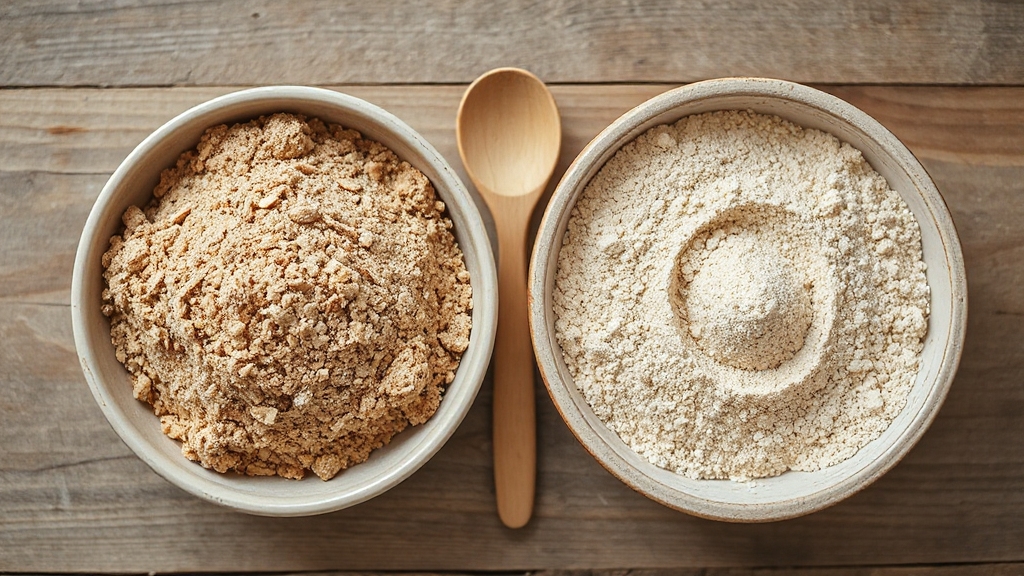
Have you ever wondered about the difference between wholemeal and whole wheat flours? You’re not alone. These terms often confuse bakers, but they fundamentally refer to the same thing: flour made by grinding the entire wheat grain, including bran, endosperm, and sometimes germ.
In the UK, you’ll hear “wholemeal flour,” while in the US, it’s called “whole-wheat flour.” Despite the naming, both retain the grain’s natural components, unlike refined flours.
Look closely, and you’ll notice slight regional variations. The US often mills hard red wheat, while the UK may use white wheat, reflecting local preferences.
This type of flour is ideal for baking recipes like chocolate sourdough bread, offering enhanced fiber and nutrient content for healthier loaves.
Nutritional Profiles Compared
While wholemeal and whole wheat flours are fundamentally the same, their nutritional edge over white flour is undeniable. You’ll find they pack more fiber—about 11g per 100g compared to white flour’s 2.4g—plus higher levels of B vitamins, iron, magnesium, and zinc.
Wholemeal and whole wheat flours outshine white flour with 11g of fiber per 100g versus 2.4g, plus richer nutrients for better health.
They’re also lower in calories per cup and have complex carbs for steadier blood sugar control. Notably, whole grain wheat flour offers significantly more fiber, with 12.8g per cup higher fiber content compared to white flour’s 3.3g, supporting better digestive health. Additionally, their fermentation process can lower glycemic index, making them a suitable choice for health-conscious individuals.
Feel the difference when you choose whole grains; they nourish you deeply with:
- Vitality: More nutrients fuel your body’s needs.
- Protection: Antioxidants guard against cellular damage.
- Comfort: High fiber supports your gut, easing digestion.
- Hope: Reduced risks of heart disease and diabetes empower your future.
Make the switch; you’re investing in health with every bite of wholemeal or whole wheat.
Milling Techniques and Textures
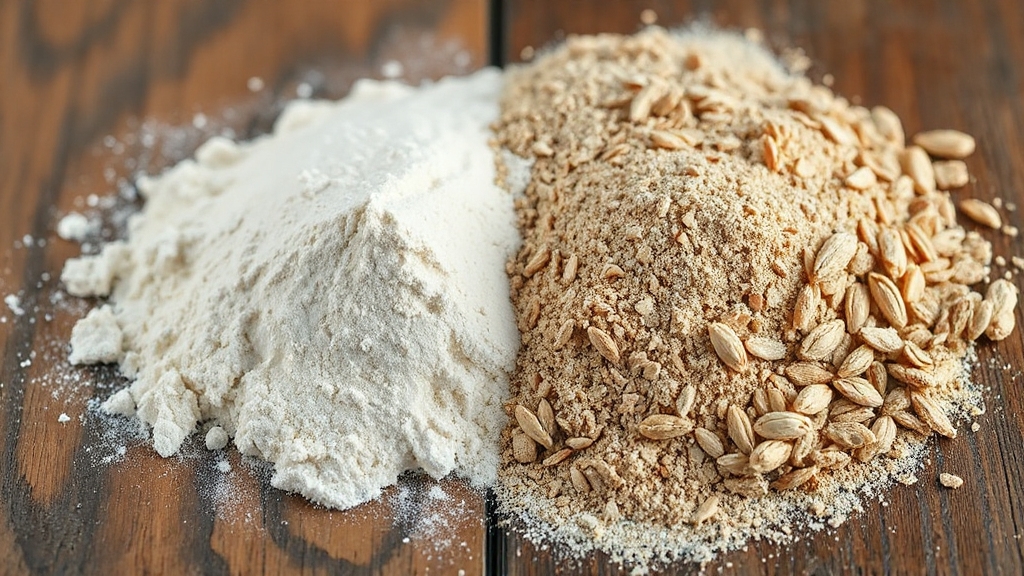
Notice how the nutritional benefits of wholemeal and whole wheat flours set them apart from refined options, but there’s more to contemplate with how they’re made. When you explore milling techniques, you’ll see stone milling runs hotter, potentially reducing nutrients like amino acids, while roller milling keeps temperatures low, preserving them.
Stone mills use single-stream grinding, keeping all grain parts together, whereas roller mills often separate and recombine components for whole wheat flour.
You’ll also notice texture differences. Wholemeal flour feels coarser due to bran inclusion, while whole wheat’s coarseness varies by milling process. Freshly milled flour has weaker gluten, and whole grain flours absorb more water, affecting dough consistency.
Additionally, the milling process can influence the final nutritional content of the flour, as whole grain flours retain more nutrients compared to refined varieties. Understanding gluten-free alternatives, such as using a gluten-free flour blend, can also be beneficial when adapting recipes for dietary needs.
Milling methods and grain variety directly shape these characteristics.
Baking Properties and Challenges
As you plunge into baking with wholemeal and whole wheat flours, you’ll quickly find that their properties present distinct challenges compared to refined flours. Their higher bran and germ content demands more water, often leading to stickier doughs and denser baked goods if hydration isn’t adjusted—think increasing liquid by 5–10%.
Additionally, the bran in wholemeal flour can weaken the dough structure by interfering with gluten formation, making it harder to achieve a light texture (bran cuts gluten strands). To counter this, consider longer fermentation times, much like the extended process used with a sourdough starter to develop deeper flavors and improve texture.
Bran also cuts gluten strands, slowing development and reducing rise, while faster fermentation from wild microorganisms heightens over-proofing risks.
Feel the struggle and triumph as you adapt with these challenges:
- Frustration with heavy, tight crumbs.
- Determination to master hydration tweaks.
- Anxiety over timing fermentation just right.
- Joy in crafting hearty, wholesome loaves.
Start with a 50% substitution, extend resting times, and monitor proofing closely for success.
Flavor and Color Differences
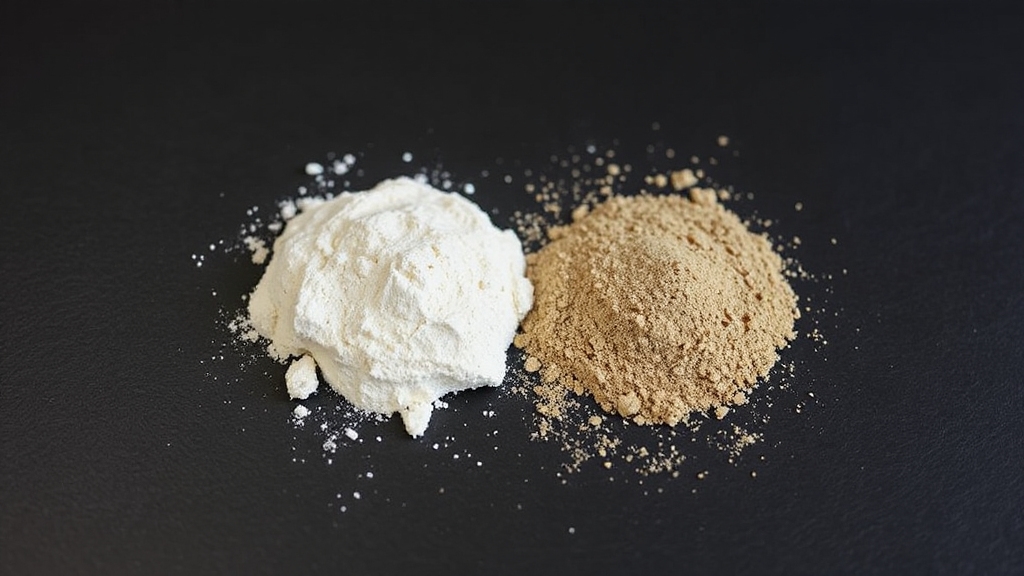
When you explore the world of wholemeal and whole wheat flours, you’ll immediately detect distinct flavor and color differences driven by their unrefined nature. You’ll notice both flours boast a nutty, rich taste from the bran and germ, far more complex than refined flours.
Sprouted whole wheat offers a milder flavor, while ancient strains like Kamut and Spelt bring a subtle sweetness. Additionally, the robust flavor profile of these flours can enhance the overall taste of baked goods, making them richer in nutrients. Using whole wheat flour in sourdough bread can further intensify its complex flavor profile, resulting in a denser, more satisfying loaf.
In terms of color, you’ll see whole wheat flour’s darker hue due to the nutrient-rich bran. White wheat varieties appear lighter, and ancient grains like Spelt can also be less intense in shade.
Compared to refined white flours, these whole grain options consistently look darker, with slight variations based on wheat type and milling processes.
Regional Naming Variations
Feel the frustration and curiosity with these differences:
Ever felt puzzled by ingredient terms? These regional differences can spark frustration and curiosity in your cooking adventures!
- Ever mixed up a recipe due to unclear terms?
- Imagine baking with “atta” expecting US “whole wheat”!
- Frustrated by inconsistent labels abroad?
- Surprised by UK “wholemeal” in a US store?
These variations impact recipes and shopping globally, so pay attention to regional terms. Checking package labels for terms like “whole grain” or specific grain content can help clarify these differences. Similarly, understanding terms like semolina can prevent mix-ups, as it refers to a specific type of durum wheat product used widely in pasta and bread.
Health Benefits and Dietary Impact
Diving into the health benefits and dietary impact of wholemeal and whole wheat flour, you’ll find they’re packed with essential nutrients that refined flours lack. Both flours retain the bran and germ, delivering high fiber content that supports digestion, satiety, and regular bowel movements.
You’ll also get crucial vitamins and minerals like iron and magnesium, plus antioxidants to combat oxidative stress. Incorporating these flours into your diet can contribute to overall wellness, as they are equally nutritious options due to their complete grain components.
Studies link whole grains to a lower risk of heart disease, type 2 diabetes, and certain cancers. They help manage weight by keeping you fuller longer and stabilize blood sugar with a lower glycemic index. Using these flours in baking, such as for sourdough bread, can further enhance flavor and texture with high-quality flour options.
Unlike refined flours, they offer superior nutrition, ensuring you’re nourishing your body with every bite while reducing chronic disease risks.
Practical Tips for Usage
Moving from the health advantages of wholemeal and whole wheat flour, let’s focus on how you can use them effectively in your kitchen. Both flours bring unique textures and flavors to baking, but they require specific techniques.
Wholemeal flour, with its coarser texture, needs more liquid for hydration, while whole wheat flour blends well with others for a lighter result. Adjust rising times in yeast recipes due to their denser nature.
Remember that wholemeal and whole wheat flours retain more nutritional benefits due to the inclusion of the entire grain. For a healthier option, try using these flours in sourdough recipes to benefit from fermentation benefits and enhanced nutrient absorption.
Feel the joy of baking with these tips:
- Rediscover rustic charm with wholemeal’s nutty, hearty flavor.
- Savor the versatility of whole wheat in cakes and pastries.
- Experiment boldly with ratios for unique, soul-warming tastes.
- Craft denser, fiber-rich breads that nourish body and spirit.
Frequently Asked Questions
Can Wholemeal Flour Be Used for Pasta Making?
You can definitely use wholemeal flour for pasta making! It’s packed with fiber and nutrients, giving your pasta a healthy boost. Expect a nuttier flavor and coarser texture, though.
To avoid brittleness, mix it with refined flours like ’00’ or semolina. You’ll need to adjust the liquid content and handle it carefully, especially with a pasta machine.
Use finely milled wholemeal for the best results.
Is Whole Wheat Flour Suitable for Gluten-Free Diets?
Like a wolf in sheep’s clothing, whole wheat flour hides its gluten content under a wholesome guise. You can’t rely on it if you’re following a gluten-free diet.
Evidence shows it contains around 13.8% protein, a significant source of gluten, making it unsuitable for those with celiac disease or gluten sensitivity. Don’t risk your health; opt for alternatives like rice or almond flour to keep your diet safe and compliant.
How Does Storage Affect Wholemeal Flour’s Shelf Life?
Let’s talk about how storage impacts wholemeal flour’s shelf life. Store it in cool, dry conditions using airtight containers to block moisture and air. Keep it away from light and strong odors to prevent spoilage and flavor transfer.
Freezing extends shelf life up to six months by killing pests and preserving nutrients. Refrigeration’s also effective, though space is limited.
Room temperature works, but shelf life’s shorter, so check regularly.
Are There Specific Brands for Whole Wheat Flour?
You might think all whole wheat flour is the same, but that’s not true—brands make a big difference in quality and taste.
Check out King Arthur Premium for versatility, or Bob’s Red Mill for organic options.
Palouse Brand offers stone-ground excellence, while Arrowhead Mills ensures non-GMO purity.
For nutrition, try To Your Health’s sprouted flour.
Pick based on reviews and your baking needs; you’ll notice the difference!
Can Wholemeal Flour Be Used in Desserts?
You can definitely use wholemeal flour in desserts! It’s packed with fiber, boosting nutritional value, and its nutty flavor enhances recipes like apple cakes or honey grahams.
You’ll find it adds a rustic texture and helps retain moisture for tender results. Just adjust liquid or sugar levels if needed, as it’s denser.
Experiment with it in cookies or pancakes, and you’ll create healthier, flavorful treats!
Mix, Match, and Savor—Unlock Whole Grain Possibilities
So, you’ve navigated the grainy landscape of wholemeal and whole wheat flours, like a baker charting a course through a field of wheat. Both offer robust nutrition, distinct textures, and unique flavors, backed by evidence of health benefits.
Don’t shy away from experimenting—swap ’em in recipes, adjust hydration, and taste the difference. Pick what suits your baking needs and dietary goals, and you’ll craft wholesome, delicious results every time.

